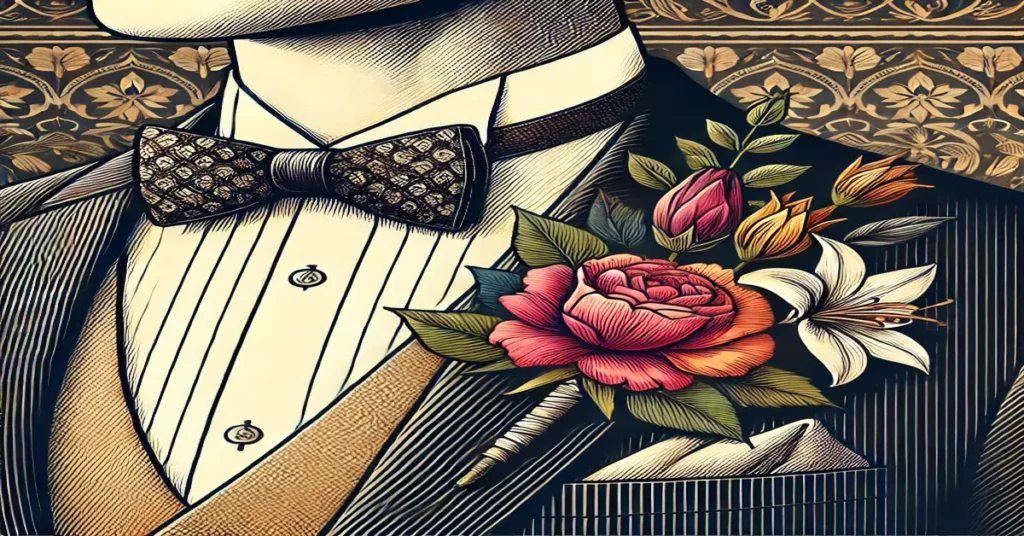The boutonniere, a small floral decoration worn on the lapel of a suit or jacket, has long been a hallmark of sophistication and personal expression. Originating from the French word for “buttonhole,” the boutonniere is a classic accessory that transcends mere decoration, carrying symbolic meanings and cultural significance. From its historical roots to its modern interpretations, the boutonniere’s continues to grace formal events, weddings, proms, and other special occasions, embodying elegance and tradition.
In this article, we will explore the fascinating history, cultural significance, styles, and modern uses of the boutonniere, as well as practical tips for crafting, wearing, and preserving this iconic accessory.
A Brief History of the Boutonniere
The tradition of wearing flowers dates back centuries, with roots in ancient civilizations that valued blooms for their fragrance, beauty, and symbolic meanings. However, the boutonniere’s as we know it gained prominence in the 19th century, particularly during the Victorian era.
Victorian Era and the Language of Flowers
In Victorian society, flowers were not just beautiful; they were a form of communication. Known as “floriography,” the language of flowers allowed individuals to convey emotions and messages through specific blooms. The boutonniere became a medium for expressing sentiments such as love, loyalty, or courage. A single flower pinned to a gentleman’s lapel could speak volumes about his feelings or intentions.
The Boutonniere in Military Tradition
Historically, the boutonniere’s also held a place in military traditions. Soldiers often wore flowers as a token of love or remembrance from their loved ones. The practice symbolized bravery and served as a comforting reminder of home during times of war.
The Significance and Symbolism of the Boutonniere
The boutonniere is not merely a decorative accessory; it carries profound symbolic meanings, often determined by the type of flower chosen.
Common Boutonniere Flowers and Their Meanings
- Rose: A universal symbol of love and passion.
- Carnation: Represents admiration and fascination.
- Lily of the Valley: Signifies purity and humility.
- Orchid: Denotes beauty, luxury, and strength.
- Lavender: Associated with devotion and tranquility.
The choice of flower can reflect personal sentiments, align with the theme of an event, or complement the overall attire.
Crafting the Perfect Boutonniere
Creating a boutonniere’s involves careful selection and arrangement of floral elements. Here’s a step-by-step guide to crafting your own boutonniere:
Materials Needed
- A fresh flower of your choice
- Greenery or small foliage for texture
- Floral tape
- Scissors
- Ribbon (optional)
- A pin for securing the boutonniere
Instructions
- Select Your Flower: Choose a fresh flower that complements your outfit and the event’s theme.
- Trim the Stem: Cut the flower stem to about 1-2 inches in length.
- Add Foliage: Incorporate small leaves or sprigs of herbs like rosemary or baby’s breath for added texture.
- Bind the Elements: Use floral tape to secure the flower and foliage together tightly.
- Wrap with Ribbon: For a polished look, wrap the stem with a ribbon that matches your attire.
- Attach the Pin: Insert a pin through the back of the boutonniere’s for easy attachment to your lapel.
How to Wear a Boutonniere
The boutonniere’s is traditionally worn on the left lapel of a jacket, as this side is closest to the heart. Most suits come with a designated buttonhole on the left lapel for this purpose.
Tips for Proper Placement
- Ensure the boutonniere is upright and securely fastened.
- Avoid using excessive pins or tape, as this can detract from the boutonniere’s elegance.
- Match the boutonniere’s style and color with the overall outfit for a cohesive look.
Occasions for Wearing a Boutonniere
Boutonniere’s are synonymous with formal events and celebrations. Here are some occasions where a boutonniere is commonly worn:
1. Weddings
The boutonniere is a staple at weddings, often worn by the groom, groomsmen, fathers of the bride and groom, and other close family members. The flower choice usually matches the bridal bouquet or wedding theme.
2. Proms
Young men wear boutonniere’s to complement their date’s corsage, creating a harmonious look for this milestone event.
3. Funerals
In some cultures, white flowers are worn as a sign of respect and remembrance during funeral ceremonies.
4. Formal Galas and Balls
A boutonniere adds a touch of refinement to black-tie events, helping the wearer stand out in a crowd.
Modern Interpretations and Trends
While traditional boutonniere’s feature fresh flowers, contemporary designs have embraced creative and unconventional elements. Modern trends include:
1. Dried Flowers
Rustic and long-lasting, dried flower boutonniere’s have become a popular choice for outdoor or bohemian-themed events.
2. Fabric Flowers
Boutonnieres made from fabric offer a customizable and durable alternative, allowing for intricate designs and unique color combinations.
3. Themed Boutonnieres
Incorporating miniature objects, such as musical instruments, sports memorabilia, or hobby-related items, adds a personal touch to the boutonniere’s.
Care and Preservation of a Boutonniere
To ensure your boutonniere’s looks fresh throughout an event, proper care is essential:
Before the Event
- Keep the boutonniere refrigerated to maintain its freshness.
- Lightly mist the flower with water to prevent wilting.
During the Event
- Handle the boutonniere by the stem to avoid bruising the petals.
- Secure it properly to prevent it from shifting or falling.
After the Event
For those who wish to preserve the boutonniere’s as a keepsake, consider drying or pressing the flower. These methods allow you to retain the boutonniere’s beauty as a lasting memory of the occasion.
Cultural Variations in Boutonniere Traditions
The boutonniere holds cultural significance in various parts of the world:
France
As the origin of the term “boutonniere,” France has a rich tradition of incorporating floral accessories in formal attire. French boutonnieres often emphasize simplicity and elegance.
United Kingdom
Referred to as a “buttonhole,” the boutonniere’s remains a staple in British formal wear, particularly at weddings and royal events.
United States
In the U.S., boutonnieres are commonly seen at proms and weddings, reflecting a blend of traditional and modern styles.
The Boutonniere in Pop Culture
From Hollywood films to royal weddings, the boutonniere’s has made numerous appearances in popular culture. Iconic moments include:
- James Bond’s dashing tuxedos adorned with a single red rose.
- The classic boutonniere’s-wearing groom in romantic comedies.
- Royal wedding ensembles featuring perfectly crafted floral arrangements.
These appearances have cemented the boutonniere’s status as a symbol of elegance and timeless style.
Conclusion
The boutonniere is more than just a decorative accessory; it is a statement of elegance, tradition, and personal expression. Whether worn at a wedding, prom, or formal gala, the boutonniere’s continues to hold a special place in fashion and culture. Its rich history, symbolic meanings, and modern interpretations ensure its relevance for generations to come.
By understanding the significance and craftsmanship behind the boutonniere’s, you can appreciate its role as a timeless accessory that adds a touch of sophistication to any occasion.
FAQs
1. What is a boutonniere? A boutonniere is a small floral decoration worn on the lapel of a suit or jacket, often during formal events.
2. How do I wear a boutonniere? The boutonniere is traditionally worn on the left lapel, secured through the buttonhole or with a pin.
3. Can I make my own boutonniere? Yes, crafting a boutonniere is simple and involves selecting a flower, adding foliage, and securing it with floral tape and a pin.
4. What flowers are commonly used in boutonnieres? Popular choices include roses, carnations, lilies of the valley, orchids, and lavender, each carrying its own symbolic meaning.
5. How do I preserve a boutonniere? To preserve a boutonniere, you can dry or press the flower after the event, turning it into a keepsake.
6. Are boutonnieres only for men? No, boutonnieres can be worn by anyone wishing to add a floral accent to their formal attire.







